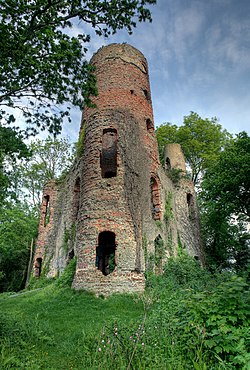Racton Monument
| Racton Monument | |
|
Sussex | |
|---|---|
 Multi-turreted triangular tower with much built-up damage | |
| Type: | Folly |
| Location | |
| Grid reference: | SU77650947 |
| Location: | 50°52’46"N, -0°53’51"W |
| Village: | Racton |
| History | |
| Built 1766–75 | |
| By: | Theodosius Keene |
| Folly | |
| Information | |
| Owned by: | Mark Talbot |
Racton Monument (known locally as Racton Ruin) is a folly tower standing on a hill in Racton, Sussex, in the very south-west of the county with views over Chichester Harbour and to the Isle of Wight across in Hampshire. The tower was commissioned by George Montagu-Dunk, 2nd Earl of Halifax, either as a summerhouse for the nearby Stansted Estate or so he could watch his merchant ships dock at the nearby port, Emsworth, on The Solent.[1] One news report states that the lower level was also to be used for holding banquets.[2]
The tower is a Grade II listed building.[3]
History
The tower was designed by architect Theodosius Keene, son of the celebrated architect Henry Keene,. It was built between 1766 and 1775 and some sources suggest that it has been called 'Stansted Castle'.[1][4]
The Listing summary states that the design featured a triangular base, with a round turret at each angle. Of a red brick construction, the building was originally faced with flints and stood four storeys high (79 feet), a height it retains to this day. However, it has been abandoned for over a century and is in a state of ruin, with the floors and much of the original flint facing having disappeared, and its roof caving in.
Planned restoration and conversion
The property is privately owned by the architect Mark Talbot (since 1987). His application for planning permission to turn it into a dwelling was refused in August 2020 by the South Downs National Park Authority. The decision stated that the conversion would lead to an "'unsympathetic form of development', due to the intended scale, design and appearance" and that the owner had provided "insufficient information had been provided to justify the impact of the proposals", according to a news report.[5]
Planning consent for a conversion to a private dwelling had been provided in 1991 by Chichester District Council, but work did not begin and the consent expired in April 2013. Prior to converting the folly into a residence, Talbot had planned to "replace the missing elements, both structural and decorative, and to refurbish the building as far as practical to match the original design" according to a June 2020 news report.[2]
Condition and concerns
By February 2012, the tower's condition described as follows: "Flint deterioration (peeling from brick core), particularly bad to South elevation. Severe brick deterioration to west window. Numerous sills dropped".[6]
In 2020, Mark Talbot said that the folly had been "a focal point of 'undesirable and sometimes illegal gatherings' as well as suffering from fly tipping, and dumping of cars".[2] Occult acts were said to have taken place on occasion at the ruined folly.[7][8]
According to Country Life, the tower 'has seen illegal raves, ghost hunts, occultists and graffiti, and was, reputedly, a 19th-century brothel'. Local lore suggests "spectral sightings [that] include flying bricks, faces in windows and a ghost tractor that drives up behind you, then disappears".[1]
Gallery
-
Racton Monument from above
-
Front of the monument
-
Looking up to the top of the monument
-
Looking north toward the monument
-
The monument at night
References
- ↑ 1.0 1.1 1.2 "Racton Folly, West Sussex: Flying bricks, faces in windows and a ghost tractor that sneaks up behind you". Country Life. 13 January 2021. https://www.countrylife.co.uk/out-and-about/racton-folly-west-sussex-flying-bricks-faces-in-windows-and-a-ghost-tractor-that-sneaks-up-behind-you-221565.
- ↑ 2.0 2.1 2.2 "Fresh plans to convert historical monument into home on Chichester border". Chichester Observer. 25 June 2020. https://www.chichester.co.uk/news/people/fresh-plans-convert-historical-monument-home-chichester-border-2894471.
- ↑ National Heritage List 1026188: The Racton Monument (Grade II listing)
- ↑ "The curiosity of Racton Folly". https://bitaboutbritain.com/curiosity-racton-folly/.
- ↑ "Plans to convert historical monument into home on Chichester border refused". Chichester Observer. 3 September 2020. https://www.chichester.co.uk/news/people/plans-convert-historical-monument-home-chichester-border-refused-2960781.
- ↑ "Racton Monument STOUGHTON". Chichester District Council.. 14 February 2012. https://www.chichester.gov.uk/media/15416/Racton-Monument-Stoughton/pdf/Racton_Monument__Stoughton.pdf.
- ↑ "Racton Ruins". ePhotoZine. 31 December 2011. https://www.ephotozine.com/photo/racton-ruins-21411598.
- ↑ "Racton Tower". Castles.nl. 9 June 2012. https://www.castles.nl/racton-tower.




